 phototropic/E+ via Getty Images
phototropic/E+ via Getty Images
Tile and laminate are both smart flooring choices, with ample varieties to suit any budget. Tile is generally more expensive but also more durable than laminate. Laminate is less expensive and better suited to DIY installation. Explore the pros and cons of tile and laminate to decide which is the best for your home in terms of budget, durability, and aesthetics.
On This Page:
- What’s the Difference Between Tile and Laminate Flooring?
- Tile vs. Laminate Flooring: Which is Better?
- Tile vs. Laminate Flooring: Which is Best for Your Home?
- Tile vs. Laminate vs. Vinyl Flooring
What’s the Difference Between Tile and Laminate Flooring?
 Jacek Kadaj/Moment via Getty Images
Jacek Kadaj/Moment via Getty Images
Tile for flooring is usually natural stone or human-made in the form of ceramic, porcelain, or resin. Tiles are a single, solid layer that sometimes have a sealant to prevent moisture absorption and staining. Laminate flooring, whether in tile or plank form, consists of multiple human-made layers. High density fiberboard makes up the rigid base layer, followed by an image layer, and topped with a plastic wear layer.
Tile Flooring
Tile flooring ranges from rugged, natural stone like slate or limestone to sleek, shiny ceramic, porcelain, or resin. Tile flooring costs between $9 and $65 per square foot, installed.
Types of Tile Flooring
| Type | Cost per Square Foot | Description |
|---|---|---|
| Ceramic | $9–$44 |
Ceramic tile costs less than most Most common type Excellent variety Great for high traffic and damp areas |
| Porcelain | $11–$44 |
Harder than ceramic so extremely durable Resists cracking and chipping Suitable for high-traffic and high-moisture areas |
| Slate | $12–$35 |
Natural stone Requires sealing and regular maintenance |
| Travertine / Limestone | $10–$44 |
Porous natural stone Excellent durability when sealed |
| Granite | $18–$50 |
Most common stone type Large selection of unique colors and designs Requires sealing and maintenance |
| Marble | $11–$65 |
Natural and artificial varieties Prone to scratches and staining Good in low traffic spots, trim, accents, counters and accents |
| Fired Stone | $10–$50 |
Fired stone tiles Extremely hard and durable Naturally slip resistant |
| Resin | $10–$50 |
Unique designs Can dent, chip and scratch easily Use as accents or for walls, ceilings and backsplashes |
Laminate Flooring
 Madhourse/iStock/Getty Images Plus via Getty Images
Madhourse/iStock/Getty Images Plus via Getty Images
Laminate comes in plank or tile form. Planks usually mimic the look of wood while tiles mimic stone or porcelain. You can also find ones with interesting patterns and prints like mosaic or mandala prints. Laminate flooring costs $3 to $10 per square foot, installed.
Types of Laminate Flooring
| Type | Cost per Square Foot | Description |
|---|---|---|
| Plank | $3–$10 |
Laminated planks made from wood, resin, glues and wood dust Extremely durable but can’t be refinished |
| Tile | $3–$10 |
Mimics stone and ceramic tiles but for half the price Wide range of styles, colors and designs |
Tile vs. Laminate Flooring: Which is Better?

Catherine Falls Commercial/Moment via Getty Images
Tile and laminate flooring have an extensive range of benefits that make them popular options for flooring in any room, whether you’re doing a kitchen remodel or freshening up the hallway. Let’s explore which type of flooring performs best in each of these important categories.
Appearance
Appearance is a key factor when it comes to flooring, as it impacts the look of your whole room and everything in it. Plus, a beautiful, well-maintained floor can add to the resale value of your home.
Laminate Flooring Pros:
- No grout, so you don’t have to worry about it yellowing or looking grimy over time
- High-end laminate convincingly mimics the look of real wood or stone
- More even surface than tiles
- Limitless appearance choices as the photographic layer can mimic any material or hold any pattern
Laminate Flooring Cons:
- Pattern repetition makes laminate appear “fake” because it’s too even
- On budget materials, the top layer is sometimes so glossy it makes the flooring look obviously fake
Tile Flooring Pros:
- Stone tiles have a rugged, natural appearance
- Lots of choice in color and stone type
- Endless pattern, color, and style variations in manufactured tiles like porcelain, ceramic, and resin
Tile Flooring Cons:
- Grout can eventually turn yellow or gray
- Mildew and mold can build up on the grout in damp areas
Cost
Cost is a significant factor when it comes to choosing flooring, particularly if you’ve got a big space to cover. If you’ve got your heart set on high end marble tiles, but the cost for a whole room is just too much, consider just using marble around the periphery or to create a focal point in the center of the space, then use cheaper tile to cover the rest.
Tile:
Tile flooring costs between $9 and 65 per square foot, depending on the type of tiles. Ceramic costs the least, starting at $9 per square foot, installed.
Laminate: Laminate is less expensive than tiles per square foot, costing between $3 and $10, including installation.
Ease of Installation
 LightFieldStudios/iStock/Getty Images Plus via Getty Images
LightFieldStudios/iStock/Getty Images Plus via Getty Images
For both laminate and tiles, it’s best to hire a flooring specialist if you want to finish your flooring project to a high standard in a reasonable timeframe. However, if you really want to tackle this project yourself, here are the pros and cons of choosing the DIY route for each material.
Tile Installation Pros:
- Pre-cut tiles easy to install
- Can be installed over existing floors
- Can be installed below grade
Tile Installation Cons:
- If you make a mistake its difficult to reverse
- Stone tile is heavy and hard to cut
- Requires mixing mortar or grout
- Spacing tiles correctly is challenging
Laminate Installation Pros:
- Quick and easy to install
- Tongue and groove planks are easy to cut with miter saws
- Can be fitted over existing floor
- Underlayments can cadd insulation and control noise
Laminate Installation Cons:
- You must place flooring in the area you’re installing it in for 48-72 hours to acclimatise it.
- New laminate flooring has a distinctive chemical smell that can take up to a week to dissipate
- Can release volatile organic compounds (VOCs) that pose a potential health risk
Durability
 maskalin/iStock/Getty Images Plus via Getty Images
maskalin/iStock/Getty Images Plus via Getty Images
Your flooring, particularly in high-traffic areas, is exposed to a lot of wear and tear, so it’s vital that the product you choose is tough enough to keep up with those demands.
Tile Durability Pros:
- Tile is tough, durable, and hard to crack
- If you damage a single tile, you can simply replace that one tile
- Can withstand high amounts of foot traffic
- Doesn’t scratch
Tile Durability Cons:
- “Destructively hard” tiles can cause mutual destruction when things fall on them.
- May require sealing, depending on the type of stone, to increase stain resistance and improve durability
Laminate Durability Pros:
- Resists scratches
- A single plank or tile can be replaced
Laminate Durability Cons:
- Can’t be revarnished or resealed
- Once wear layer is gone, the floor needs replacement
Repair and Maintenance
Repairing and maintaining a floor should be relatively painless and simple. Both tile and laminate are fairly easy to clean and maintain. And, for resealing and repair jobs, hiring a local flooring pro ensures you get the best results with minimal effort.
Tile floor repair and maintenance pros:
- Easy to clean
- Does not absorb moisture if sealed properly
- Repair (or replace) individual tiles if necessary
- Generally doesn’t scratch
- Easy to reseal to maintain water and stain resistance
Tile floor repair and maintenance cons:
- Will need regrouting periodically
- Grout requires regular scrubbing and whitening
Laminate floor repair and maintenance pros:
- Easy to clean with vacuum or broom
- A single plank or tile can be replaced if damaged
- Doesn’t require resealing
Laminate floor repair and maintenance cons:
- Cannot be refinished or resealed
- Cannot tolerate too much water
- Planks can shrink over time, leaving unsightly gaps around the edge of the room and at joins
Moisture Resistance
Moisture resistance is crucial for flooring in bathrooms, kitchens, and hallways. Plus, accidents happen, drinks get knocked over, new furry friends take a while to potty train, and sometimes life gets messy. So it’s important that the flooring you choose can withstand the demands of everyday life.
Tiles:
- If sealed correctly, tile is waterproof
- Some stone tiles need periodic resealing to maintain their water resistance
Laminate:
- Water resistant to a degree, but you must clear spills up immediately
- Bottom layers of laminate are made from fiberboard so if water penetrates the boards or through the joins, the fiberboard gets soaked and irreparably damaged
Heat Resistance
Heat resistance is an important factor if you’re planning to lay a floor in your kitchen, as hot food, water, and pans may accidentally land on it.
Tiles:
- Most tiles are heat resistant and resistant to cracking and discolouring over time with repeated exposure to heat
Laminate:
- Temperature fluctuations can cause laminate to expand and contract
- Intense heat can cause laminate to blister and bubble
Tile vs. Laminate Flooring: Which is Best for Your Home?
Tile and laminate flooring both have appealing qualities as interior flooring options. However, the room you’re remodeling and your lifestyle both impact which type of flooring you should choose. You can always get expert advice from a local flooring installer.
Which is Best for Homes With Pets?
Both laminate and tile are a good choice for pets, but there are a few things to consider. Laminate and some tiles are slippery for humans and particularly pets. Therefore, if you have animals, it’s best to choose textured laminate or natural stone that’s already slip-resistant. Both options are easy to clean if your pet has an accident, but because laminate has a fiberboard base, repeated accidents that breach the water-resistant layer will cause damage.
Which is Best for Bathrooms?
Tile is the best flooring for bathrooms. Although it can be slippery unless you use a textured tile, it’s still better than laminate. Tiles such as porcelain are waterproof, whereas laminate is only water resistant. With continual exposure to moisture, laminate will quickly buckle and peel.
Which is Best for Homes With Kids?
Laminate is probably the best choice for homes with kids. Tile is extremely hard, so trips and falls are often more painful than with a laminate floor. Laminate wipes clean easily and is less likely to crack if someone drops something heavy on it.
Tile vs. Laminate vs. Vinyl Flooring
Vinyl flooring is synthetic and consists of layers of fiberglass, PVC, a photographic layer, and multiple thin wear layers. Vinyl doesn’t look as realistic as laminate as it tends to be a little glossier and look more like an image than the real thing. Vinyl, unlike laminate, is waterproof, so is suitable for use in bathrooms and kitchens. For cleaning and maintenance, vinyl is much easier than tile or laminate. Vinyl flooring costs $5 to $10 per square foot, including labor and materials.
Consult With a Flooring Pro Today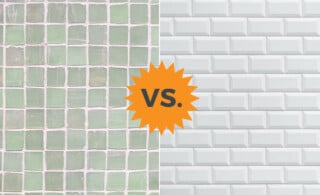 Porcelain vs. Ceramic Tiles
Porcelain vs. Ceramic Tiles 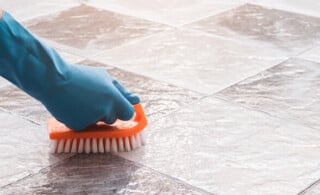 How To Clean Tile Floors
How To Clean Tile Floors 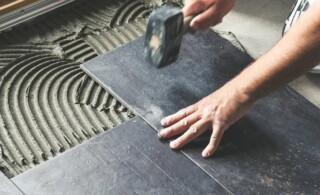 Cheap Tile Flooring Buying & Installation Guide
Cheap Tile Flooring Buying & Installation Guide 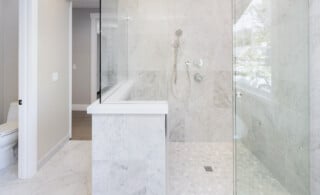 The Best Tile for Shower Floors
The Best Tile for Shower Floors 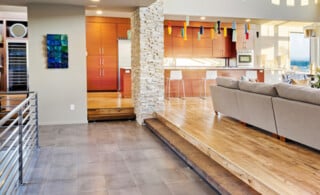 Find the Perfect Flooring: The Pros, Cons and Costs of Top Flooring Materials
Find the Perfect Flooring: The Pros, Cons and Costs of Top Flooring Materials 

Are You Familiar With This Topic? Share Your Experience.